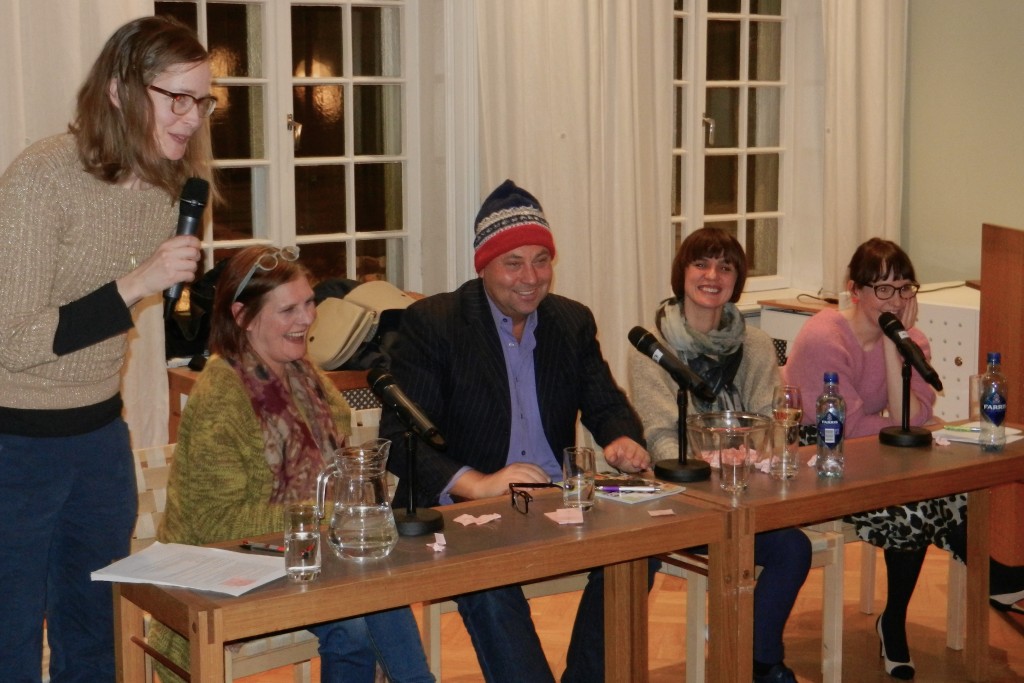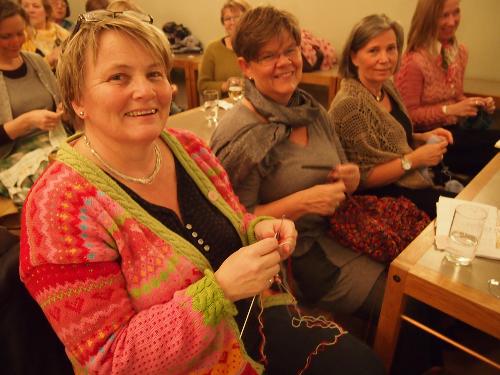 The topic of the debate organized by NFF, Norsk faglitterær forfatter og oversetter forening/Norwegian Non-fiction Writers And Translators Association was; What makes a knitting book successful, and what started the current knitting wave in Norway? The evening started with nearly a 100 attendees – a mixture of authors, journalists, reporters, knitters and other interested persons – facing a panel consisting of Pickles founders: Anna Enge and Heidi Grønvold, publisher MD Arve Juritzen of Marius Strikkebok (85 000 copies sold, see my post Craft Wave), author Kristin Wiola Ødegard, and chaired by Kristin Isaksen communications leader at NFF. First, the panel introduced themselves, and told us what they believed to be the future of the knitting book. The Pickles’ girls were surprised that their 3 books containing patterns, all previously published online, still sold like hotcakes and believed knitters wanted their patterns gathered in print form – a bit like the way a squirrel hoards or stash – and that the knitting wave is a revenge of the knitting nerd. You could hear the collective nod, since we all have a stash of yarns and books. In addition, knitting is now accepted in public spaces, formerly unheard of. Juritzen was taken back by the Marius book success, but believed it to be due to its storytelling ability, and told us that they now receive about 2 new knitting book proposals a week. Juritzen himself is convinced that a knitting book should be summed up in one sentence for it to have a chance of a success. Kristin’s book explains itself in the title, strikes a blow for the use of waste yarn, and was inspired by her customers’ demand at the yarn shop, Tjorven but is not published by Juritzen but by Gyldendal.
The topic of the debate organized by NFF, Norsk faglitterær forfatter og oversetter forening/Norwegian Non-fiction Writers And Translators Association was; What makes a knitting book successful, and what started the current knitting wave in Norway? The evening started with nearly a 100 attendees – a mixture of authors, journalists, reporters, knitters and other interested persons – facing a panel consisting of Pickles founders: Anna Enge and Heidi Grønvold, publisher MD Arve Juritzen of Marius Strikkebok (85 000 copies sold, see my post Craft Wave), author Kristin Wiola Ødegard, and chaired by Kristin Isaksen communications leader at NFF. First, the panel introduced themselves, and told us what they believed to be the future of the knitting book. The Pickles’ girls were surprised that their 3 books containing patterns, all previously published online, still sold like hotcakes and believed knitters wanted their patterns gathered in print form – a bit like the way a squirrel hoards or stash – and that the knitting wave is a revenge of the knitting nerd. You could hear the collective nod, since we all have a stash of yarns and books. In addition, knitting is now accepted in public spaces, formerly unheard of. Juritzen was taken back by the Marius book success, but believed it to be due to its storytelling ability, and told us that they now receive about 2 new knitting book proposals a week. Juritzen himself is convinced that a knitting book should be summed up in one sentence for it to have a chance of a success. Kristin’s book explains itself in the title, strikes a blow for the use of waste yarn, and was inspired by her customers’ demand at the yarn shop, Tjorven but is not published by Juritzen but by Gyldendal.
Second, after the interval, the knitting needles were still going strong, it was our turn to join the debate and ask questions. Researcher Ingunn Grimstad Klepp from Sifo, author of Ren Ull/Pure Wool, pointed out that the Knitting Wave did not start in Norway but that we were merely on the edge of it, and that it originated in the US or the UK. The opinions varied to why it occurred, but the Financial crisis; the creative urge that has arisen; the knitting society that the social media have helped to build; knitting’s ability to remove restlessness and to reclaim time, as well as how relaxing it is were some that were mentioned.
The debate sidetracked when the questions if yarn customers ask where the yarn is produced, and how it behaves were raised. Suddenly, we reached a why yarns pill debate, where the opinions differed especially on how much the person wearing it mattered – friction – but most agreed that it is due to the mixed fiber content (usually with man-made fibres), the degree of twist, short staple fibres, and loose knitting.
What is the next knitting hit going to be, asked Juritzen. No one had a clear answer but casual top-down kofter/traditional jackets was one of the suggestions. Designer and journalist – as well as Editor-in-chief – Nina Grønlund Sæther pointed out that designer Tove Fevang with more than 400 000 sold crafts books would be the right person to ask since she was present. Tove told us that her two latest books on childrens wear based on classic patterns had been successful. As for the next hit, she believes in the necessity of adding finishing techniques to her books since we can no longer rely on the transferring of skills between the generations. Grandmother will not always be around to take over the finishing process of a garment. In the photo above is Nina in the front, next to Denise Samson – designer and translator – Tove Fevang and me at the end (read: I did not know if I would fit into the photo).
Beautiful photos are important to attract the knitters, Kristin pointed out and Juritzen agreed. He had been surprised of the casual approach to this only a few decades back. Designer, blogger and podcaster Ann Myhre – aka Pinneguri/The Needle Lady – pointed out that with Ravelry and the free access to knitters’ own photos to link to the pattern page, that photos on single patterns did not necessarily need to be stunning. Ann’s own success with the Sinnasau/Where-the-wild-sheep-roam pattern proves her point. Just take a look at all the different versions of the jacket. Here is Ann’s summing up of the evening: nuppedebatten.
A reporter from the Norwegian State Broadcaster was present and could reveal that there will be yet another slow television program – see slow-tv-norwegian-movement-nrk – related to knitting this autumn. It will focus on hobbies and craft. We are waiting in anticipation, and comments flew in the audience that the level must be higher than on the previous program. Third, there was a book draw donated by the panel, and 7 happy winners were found. One of them, believed in giving something back, and donated a knitted Marius hat to Juritzen and you can see his happy face in the top photo.
It certainly was a heated debate at times, and it took turns we had not anticipated. Several of us would have liked to have seen Cappelen Damm, the largest of the Norwegian craft book publishers present in the panel, and a stricter chairman, but what a crowd, NFF had managed to attract. Finally, we were encouraged to send book proposals to Juritzen – yes, preferably to be summed up in a sentence – and to apply for grants at NFF. Here is the review, and a recording in Norwegian, with very low sound, from NFF: Strikkedilla.


This sounds like it would have been a fun event … though I was puzzled to read the word “debate” describing why yarns pill. Isn’t that sort of like debating why milk sours? 🙂 And I hadn’t realized (1) knitting experienced a resurgence in Norway, or (2) that knitting in public was considered in bad taste. I vividly remember my tante Marit knitting a skirt as we ate lunch in the sun at the Dyreparken in Kristiansand (in the 1980s). And she was the prim and proper daughter of a minister. 🙂 Also interesting as to the linking of the resurgence of knitting to its popularity in the US and UK. Yet any fiber art resurgence can be linked to one (or several) of many events: wants and restrictions brought on by wars (e.g., the U.S. Civil War or either of the World Wars), as a sort of political protest toward a growing industrial society (e.g. the “hippies” of the 1960s turned “back to the land” including “resurrecting” hand-made clothing, homemade bread, etc. With current popularity in the U.S., I have noted the trend to use rather expensive yarns to knit an astounding number of shawls, shawlettes, socks, cowls, scarves, fingerless mittens and hats … but much less attention to knitting and designing (not to mention wearing) sweaters, skirts and jackets! 🙁
Yes, it certainly was! Yes, a bit but it focused on how much the person wearing a sweater contributes to a sweater pilling and the opinions differed a lot so it did feel like a debate. Knitting outdoors has never been considered in bad taste, but knitting in cafés and public spaces indoors were previously unaccepted unlike today. I think that is a world wide trend, using expensive yarns knitting smaller projects, even though larger projects – especially sweaters – are still popular here in Norway.
Sounds like a interesting debate 🙂
Yes, it certainly was. Thank you, Aud!
Thanks for your detailed report Linda. Sounds like a great day.
I am happy to share and sum up the debate. It was very enjoyable. Thank you, Janie!
Once again, thank you for sharing something that I would normally never even think about!
When I think of the resurgence of knitting here in the states, I cannot help but think of September 11th, followed by our financial crisis. Following the events of 9/11, everything that felt safe and sacred was shaken to its core. Many of us strove to capture the sense of a time that was simpler, safer, calmer. For some, myself included, that meant a return to knitting, or other hand-crafts. War and the financial crisis followed shortly thereafter, and with those, the need and desire, to become more self-sufficient.
I do wish with all of my heart that none of those events had happened. But, if good comes from bad, I would say that for many Americans, there has been the turn inward for personal satisfaction, and the turn to family and self-sufficiency for our day-to-day peace. We have a long way to go as a country, and I can only hope that our government will begin to keep pace with the desires of its people, but I do have hope when I look at the generation of my son, nieces and nephews and their friends. However young they are as 20 somethings, they really do seem to have their heads on straight when it comes to what is really important. When my son’s girlfriend asks if I could teach her to knit, I am more than pleased – and encouraged.
I am delighted to, Tracy!
Yes, that sounds very logical and it is a very good point. Thank you for sharing and pin pointing the reasons for the knitting resurgence in the states. It is a great achievement if you Americans, can focus more on family and self sufficiency, I believe. I am delighted to hear that your son’s girlfriend wanted you to learn her to knit!